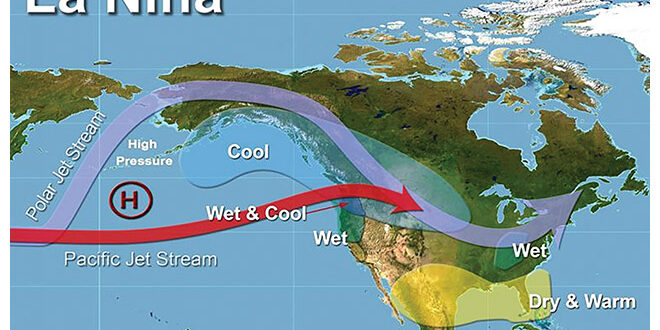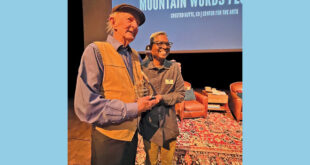Santa Slammer repeat, anyone?
[ By Kendra Walker ]
As Crested Butte heads into another winter season, La Niña is once again the name of the game. This year, the La Niña weather cycle returns for a third consecutive winter and while La Niña snowfall results vary, forecasters say we can most likely expect a similar pattern as last winter, with big storm events followed by extended periods of cold, dry weather.
“We’re seeing classic La Niña right now,” said Zach Kinler, forecaster with the Crested Butte Avalanche Center (CBAC). La Niña results in cooler than average sea surface temperatures across the equatorial Pacific Ocean, representing the cool phase of the El Nino/Southern Oscillation (ENSO) cycle. The change in sea surface temperatures directly drives our weather patterns. “What La Niña does is it promotes a high pressure in the northeast Pacific Ocean. The high pressure tends to shift the jet stream up and over the western United States, favoring the northwest and the upper midwest.”
According to the National Oceanic and Atmospheric Administration (NOAA), La Niña episodes tend to cause colder and stormier than average conditions across the North, and warmer and less stormy conditions across the south. In Crested Butte, that pressure tends to go around us putting us on the cold side of the system, with typically less moisture, said Kinler. “We’re definitely riding the line during these seasons, where just north of us sees above average precipitation probabilities, and further south you get into below average probability.”
However, that pressure does migrate back and forth and if pushed further west, that storm track goes down the coast of California and then directs storms right at our area. “Crested Butte benefits when the storms drop down and direct moisture right at Colorado,” said Kinler. “That’s what we saw last December during the big holiday storm event, that high pressure moved further into the ocean and that storm track moved right toward us. Plenty of those events can still occur when that setup is right.”
A common pattern with a La Niña year is for a big storm event to roll through followed by an extended period of dry, explained Kinler, just as we saw with last December’s storm followed by a dry January. “This year, the early season snow has put us above average with our snowpack,” said Kinler. “However, the high pressure has migrated back to the east and deflected the jet stream up and around Crested Butte. We’re in that classic situation with early season snow, then it’s dried out for a while and developed a weak layer. But if we see a big enough snow event again that layer can stabilize.”
As far as snowpack, most La Niña years have been at or below average in Crested Butte, said Kinler. According to billy barr’s snowpack data in Gothic, the area totaled 274 inches last winter. “A lot of those years we’re moving in-between phases,” says Kinler. “Right now, it’s a strong La Niña, but it’s forecast to move to neutral later this winter by February, March or April. And we’ve done really well on neutral in the past.” For example, the season of 2012/13 saw 310 inches in La Niña, followed by 463 inches the following neutral 2013/14 season.
But bottom line, it’s still hard to predict how much snow we’re going to get and when, said Kinler. “There are a lot of other processes involved globally that can tie in. La Niña is one piece of the puzzle.”
So, a few snow dances or sacrificial fires for Ullr wouldn’t hurt…
La Niña and the backcountry
“Whenever we’re getting moisture, we’re going to have elevated avalanche conditions,” said Kinler. But while there are many factors and variables to avalanche danger in any given season, he notes the benefits to a La Niña cycle that jumps between big storm event and dry period.
“We’ll see big events with heavy amounts of snow and a very active period of avalanches. Those big cycles flush out our weak layers. Once it dries out and we experience an extended period of dry with no additional loading, that tends to relieve the stress on the snowpack. So we’ll quickly go up to higher avalanche danger and quickly drop down to lower danger.”
For example, “After the large storm cycle at the end of December last winter, we saw historic avalanches,” said Kinler. “They wiped out all the weak snow and then we had six weeks of high pressure with not a lot of snow. We had low avy danger in January which is pretty rare, and it was amazing because you could ski pretty much every line you wanted to.”
He continued, “We are kind of liking these big events that wipe the slate clean, rather than a scenario with smaller storms where you never really flush out that weak layer. In those situations, we’re hanging out in the middle with considerable levels of avalanche danger and we’re having to avoid a lot of terrain.”
Kinler stressed the importance of keeping up with the CBAC’s forecasting and outreach events. “We’re out there every single day tracking to better understand what’s going on with the snowpack. We’re trying to get that word out to the public. And we always encourage further education – take an avy course, get the right gear, check our forecasts and make decisions based on what the conditions allow you to ski.”
The CBAC will be hosting its annual Avalanche Awareness Night fundraiser on December 3 at the Center for the Arts, followed by its Beacon Brush Up on December 4. “They’re both really great events, and we have a lot of local professionals coming out to offer free training,” said Kinler.
This winter the CBAC will continue to hold its Fireside Chats at local venues with speakers and updates on snowpack and weather. The CBAC will also post up at local trailheads throughout the winter season, providing conversation about avalanche conditions and offering free beacon training. Additionally, the CBAC is teaming up with the CB Nordic and Mountain Sports teams to teach avalanche education, as well as teaching snow science to students at Crested Butte Community School.
“We’re hitting the road hard to offer free training and get the word out to folks,” said Kinler. “We want to create an open forum for people to ask questions, talk about where they’ve been, share stories, make the forecast staff more accessible and keep the conversation going.”
For more daily forecast information, visit www.cbavalanchecenter.org. Avalanche Awareness Night is 6 p.m. on Saturday, December 3 at the Center for the Arts and Beacon Brush Up is from 9 a.m. to 2 p.m. on Sunday, December 4 outside the Crested Butte Community School.
 The Crested Butte News Serving the Gunnison Valley since 1999
The Crested Butte News Serving the Gunnison Valley since 1999





